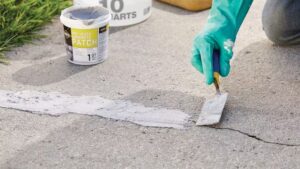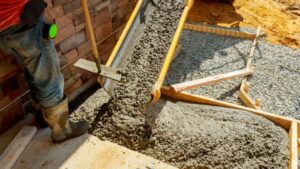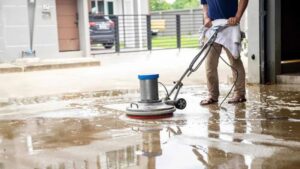Concrete floors are known for their durability, but over time they can lose their shine due to wear and tear, stains, or damage. Whether your concrete floor is in your garage, basement, or outdoor patio, restoring it can bring back its original beauty and functionality. By following a few simple steps, you can revitalize your concrete floor, making it look fresh and clean once again. In this guide, we’ll walk you through how to restore your concrete floor in just 8 easy steps, ensuring long-lasting results and a polished finish. Let’s dive in!
How To Restore Your Concrete Floor – 8 Simple Steps
1: Assess the Condition of Your Concrete Floor
Before beginning the restoration process, it’s crucial to thoroughly assess the condition of your concrete floor. Check for cracks, stains, discoloration, and any structural issues that need addressing. Some floors may only need minor touch-ups, while others might require more extensive work, such as resurfacing or deep cleaning. Proper assessment helps you identify the tools and materials you’ll need, such as patching compounds, grinders, or sealers. Taking the time to inspect your floor ensures you address all problem areas and achieve better results in the long run.
Also Read:- Tips To Prevent Concrete Cracking
2: Clean the Surface Thoroughly
Once you’ve assessed the floor, the next important step is cleaning it thoroughly. A clean surface is essential for any restoration process to work effectively. Start by sweeping away debris, dirt, and dust. For stains, grease, or oil, use a concrete cleaner or degreaser to remove any contaminants. You may need to scrub tough spots with a stiff brush or even use a power washer for deeper cleaning. Ensure the floor is completely dry before moving on to the next step, as moisture can affect the adhesion of fillers and coatings.
3: Repair Cracks and Pits
After cleaning the floor, it’s time to repair any cracks, pits, or damaged areas. Concrete patching compounds are ideal for filling in cracks or holes. Make sure to follow the manufacturer’s instructions when applying the compound, ensuring it’s spread evenly and pressed firmly into the damaged areas. For larger cracks or deeper pits, you may need to use a specialized concrete repair product or consider resurfacing the floor. Once the repairs are complete, allow the patched areas to dry thoroughly before proceeding with further steps.
4: Grind or Sand the Surface
If your concrete floor is uneven or has stubborn stains and rough patches, grinding or sanding is a necessary step to create a smooth, uniform surface. A concrete grinder or floor buffer with a diamond grinding wheel will help level the floor and remove any imperfections. Grinding not only smooths out the surface but also prepares it for further treatments like sealing or staining. Ensure you wear protective gear like goggles and a mask during this process, as it can generate a lot of dust and debris. After grinding, vacuum the surface to remove dust particles before proceeding.
5: Apply a Concrete Stain or Dye
To enhance the appearance of your concrete floor, applying a concrete stain or dye can add color and character. This is an optional step but highly recommended for those who want to give their floor a decorative touch. Concrete stains come in various shades, from subtle earth tones to vibrant colors, allowing you to customize the look to match your space. Dyes, on the other hand, offer more vivid colors. Before applying, make sure the surface is clean and dry, and follow the manufacturer’s instructions for best results. Once applied, allow the stain or dye to fully dry.
6: Seal the Concrete
Sealing the concrete is a crucial step in the restoration process as it protects the floor from future damage, such as moisture, stains, and wear. Choose a high-quality concrete sealer that suits your floor’s location and intended use, whether it’s indoors, outdoors, or exposed to heavy foot traffic. There are two main types of sealers: penetrating sealers, which soak into the concrete and provide long-lasting protection, and surface sealers, which form a protective layer on top. Applying the sealer evenly with a roller or sprayer will ensure optimal coverage. Allow the sealer to dry completely before stepping on the floor.
7: Polish the Concrete Floor
Polishing is an optional yet highly effective way to give your concrete floor a glossy, refined finish. Using a concrete polishing machine or buffer, you can achieve different levels of shine, from matte to high gloss, depending on your preference. Polishing not only improves the aesthetic appeal of the floor but also adds an extra layer of protection against dirt and wear. If you want a truly professional finish, consider using a concrete polishing compound, which will help achieve a mirror-like shine. Regular polishing will keep your floor looking pristine for years to come.
Also Read:- Difference Between Cement and Concrete
8: Perform Regular Maintenance
Once your concrete floor has been restored, maintaining it regularly will ensure it stays in great condition. Regular sweeping, mopping, and spot cleaning will prevent dirt and grime from building up. For outdoor concrete, power washing every few months can help maintain its appearance. Additionally, resealing the floor every 2-3 years will extend its lifespan and keep it protected from wear and tear. Avoid using harsh chemicals or abrasive cleaners that could damage the sealer or stain. With proper maintenance, your restored concrete floor will remain beautiful and functional for many years.
Conclusion
Restoring your concrete floor doesn’t have to be a daunting task. By following these 8 simple steps, you can breathe new life into your floors, increasing their lifespan and improving their overall appearance. Whether you’re dealing with stains, cracks, or a dull surface, this guide will help you achieve professional-looking results at home. Remember, a little care and maintenance can go a long way!
FAQs
How often should I restore my concrete floor?
Concrete floors should be restored every 5-10 years depending on wear and tear or when they appear dull and damaged.
Can I restore my concrete floor by myself?
Yes, with the right tools and guidance, you can restore your concrete floor on your own, following simple steps like cleaning, repairing, and sealing.




